Mount Rainier National Park, located in Washington State, is a breathtaking expanse of wilderness centered around the iconic Mount Rainier, a 14,410-foot stratovolcano. The park is a haven for outdoor enthusiasts, offering a mix of rugged beauty, diverse ecosystems, and abundant recreational opportunities. Using a National Park Service (NPS) map as a guide, visitors can explore the park’s highlights, from its lush valleys to its alpine meadows.
Mount Rainier National Park completely changed my perception of “natural beauty.” As an English traveller used to rolling green hills and the occasional drizzle, I thought I had a good sense of what nature had to offer—until I stood in the shadow of a 14,411-foot active volcano, surrounded by wildflower meadows, ancient forests, and glacial streams. This place operates on a completely different scale. It’s wild, majestic, and utterly humbling.
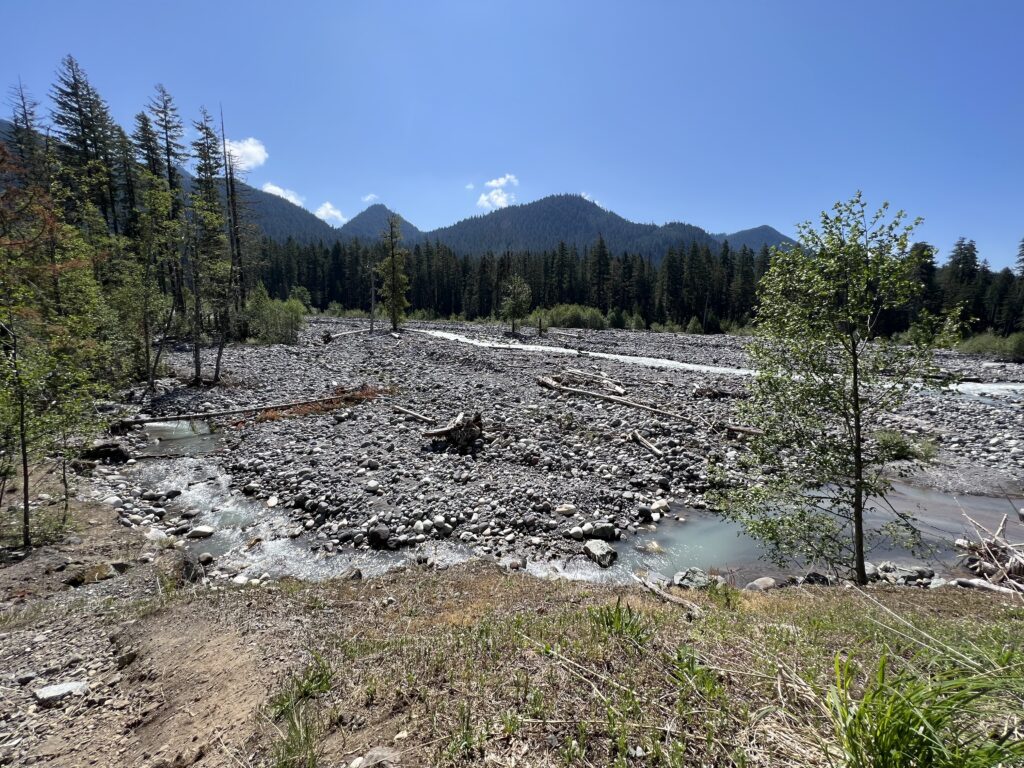
Contents
Planning Your Visit
The NPS map is an essential tool for navigating the park, identifying trailheads, and planning routes. Visitors should also check the park’s website for updates on road conditions, trail closures, and weather advisories.

Main Entrances and Visitor Centres
The NPS map highlights five main entrances to the park, each providing unique access points:
1. Nisqually Entrance (Southwest): The most popular gateway, located near Ashford, leads to the Longmire and Paradise areas.

2. Carbon River Entrance (Northwest): A quieter entryway for those seeking lush rainforests and the Carbon River Rainforest Trail.
3. White River Entrance (Northeast): Offers access to the Sunrise area, known for its sweeping views and alpine scenery.
4. Ohanapecosh Entrance (Southeast): Leads to the serene Ohanapecosh region, featuring old-growth forests and the Grove of the Patriarchs Trail.
5. Stevens Canyon Entrance (East): Connects to scenic drives and several trailheads.
Key Regions of the Park
Paradise
Marked prominently on the map, Paradise is one of the most visited areas, known for its vibrant wildflower meadows and close-up views of Mount Rainier. The Paradise Jackson Visitor Center serves as a hub for visitors, offering exhibits and trail information. Popular trails include:
• Skyline Trail: A moderately challenging hike with panoramic views of glaciers, waterfalls, and Mount Rainier.
• Myrtle Falls Trail: A short, family-friendly trail leading to a picturesque waterfall.
Sunrise
At 6,400 feet, Sunrise is the highest point accessible by car. The area is noted for its expansive vistas of Mount Rainier and the surrounding Cascades. Highlights include:
• Sourdough Ridge Trail: A moderate trail offering sweeping views of the park.
• Burroughs Mountain Trail: A more challenging hike with incredible glacier views.
Longmire
A historic district near the Nisqually Entrance, Longmire offers a mix of natural and cultural attractions. Key features include:
• Trail of the Shadows: A short loop showcasing mineral springs and lush vegetation.
• National Park Inn: A cozy lodge perfect for relaxing after a day of exploration.
Ohanapecosh
Located in the park’s southeast corner, this region is known for its old-growth forests and rivers. Must-see spots include:
• Grove of the Patriarchs: A gentle hike through a forest of towering ancient trees.
• Silver Falls Loop: A scenic trail featuring a stunning waterfall.
Activities and Recreation
The park offers year-round activities for all interests:
• Hiking: With over 260 miles of trails, the park caters to all skill levels.
• Climbing: Mount Rainier’s summit is a challenging destination for experienced climbers.

• Wildlife Watching: Look for elk, black bears, marmots, and mountain goats.
• Scenic Drives: The NPS map highlights roads like the Paradise Loopand Stevens Canyon Road, perfect for sightseeing.
• Winter Sports: Snowshoeing and cross-country skiing are popular in winter.
During My Visit
A Visit To Paradise
Getting to Mount Rainier was part of the adventure. I’d started the morning in Seattle, coffee in hand, and after about two hours of driving through lush, green scenery, I reached the Nisqually Entrance, the most popular gateway to the park. Even from the car, the views were captivating—towering evergreens, glimpses of rushing rivers, and the occasional peek at Mount Rainier’s summit playing hide-and-seek behind the clouds.
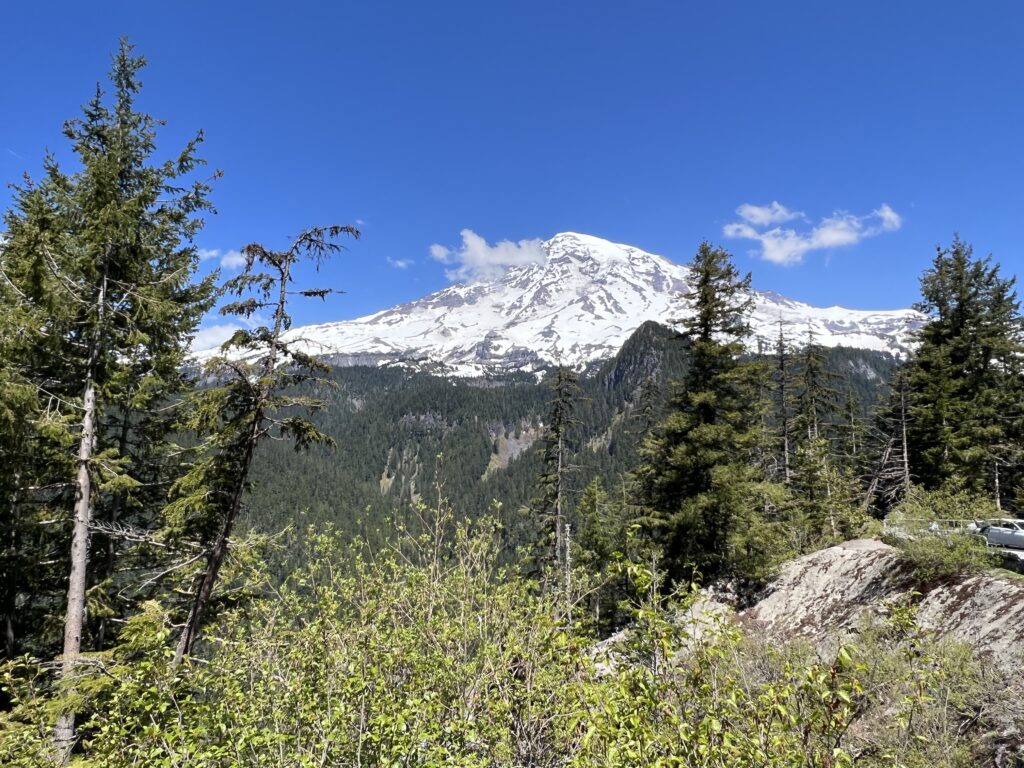
I visited in early June, the perfect time to catch the park’s transformation from snow-draped wilderness to a bursting bloom of life. The snow was still melting at higher elevations, and the rivers were roaring from the runoff. Everything felt alive, like the park was waking up for the summer season.
My destination was the Paradise area, and let me just say, it lives up to its name. The winding drive up is full of dramatic vistas, but nothing prepares you for that first clear view of the mountain. It’s absolutely massive, its snow-covered peak catching the sunlight in a way that seems almost otherworldly.
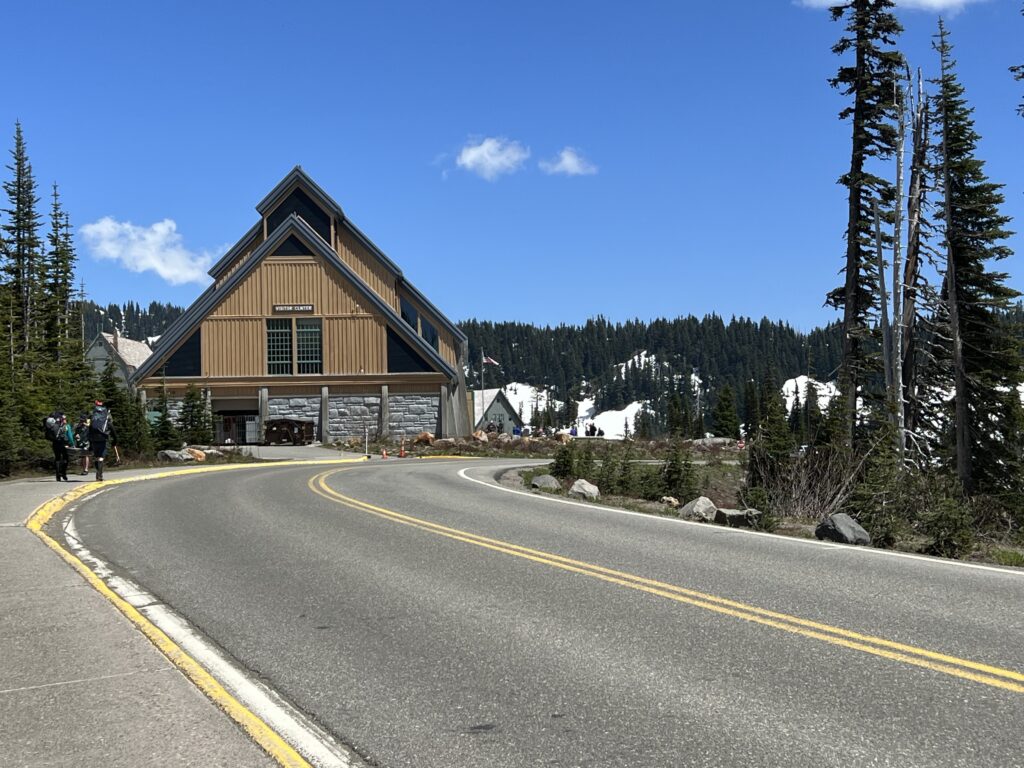
The Paradise Visitor Center is a fantastic starting point for anyone visiting Mount Rainier National Park, offering a wealth of information and a warm, welcoming atmosphere. Located in the heart of the park at an elevation of about 5,400 feet, it’s the perfect spot to learn more about the mountain, its ecosystems, and the various trails you can explore. When I arrived, the staff was incredibly helpful, offering maps, trail recommendations, and updates on conditions throughout the park. It’s also a great place to warm up with a hot drink, especially if you’re visiting in the cooler months or catching the tail end of snowmelt in June, like I did.
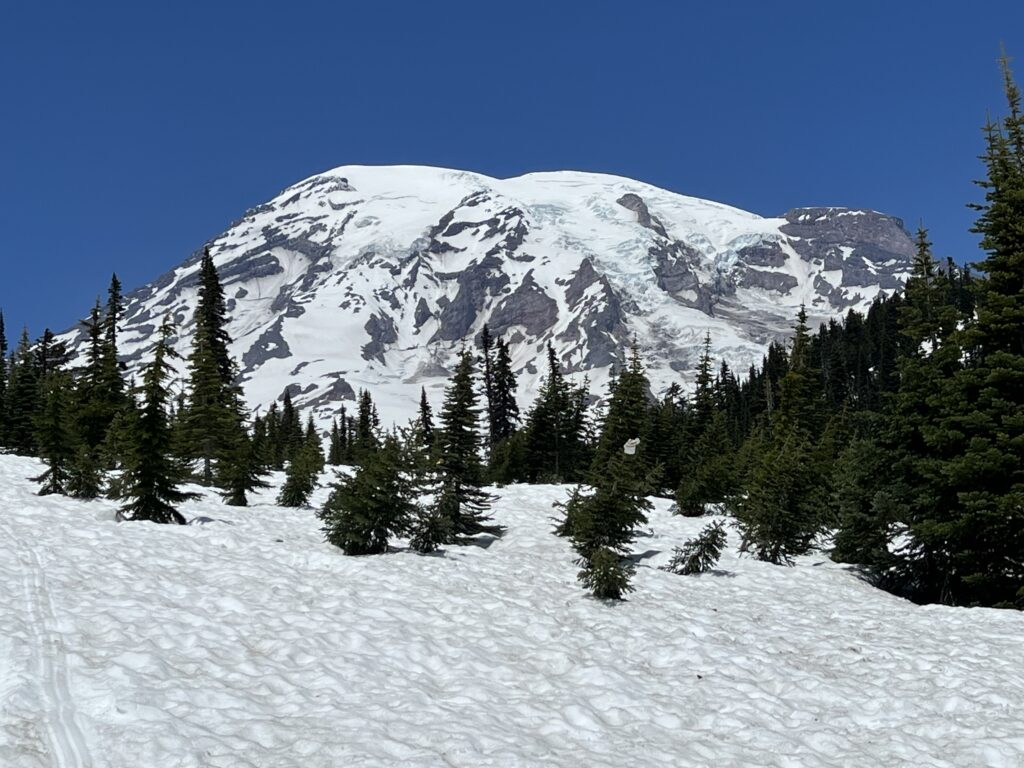
The centre has exhibits on the natural history of the area, wildlife, and the geology of Mount Rainier itself, providing a deeper understanding of what makes this place so special. For those looking to take in the views without heading out on a hike, the center’s large windows offer stunning panoramic vistas of the surrounding landscape. Whether you’re planning your next adventure or just want to relax and learn a bit more, the Paradise Visitor Centre is a must-visit stop on your journey through the park.
Reflection Lake The Breathtaking Frozen Landscape
After a quick stop at the visitor center to pick up a map and chat with a ranger (top tip: always ask for their recommendations—they know the park like the back of their hand), we set off to see reflections lake, one of the park’s most popular locations.
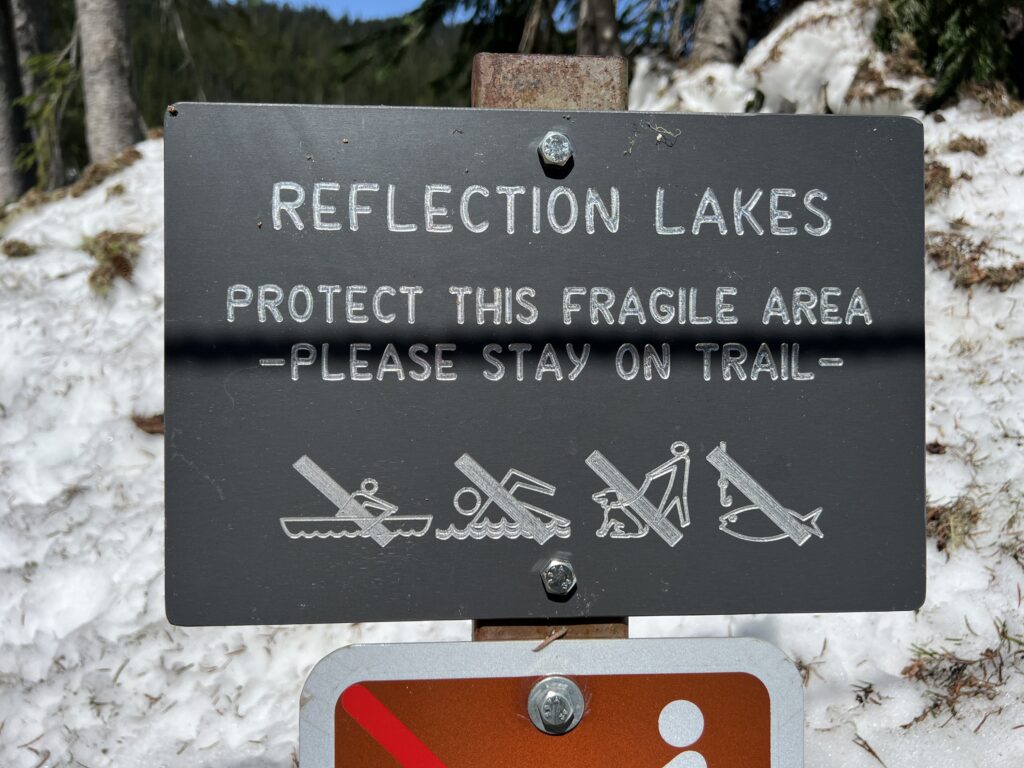
Reflection Lake is stunning stop in the park, located just off Paradise Road. The lake is famed for its incredible ability to mirror the towering Mount Rainier on calm days, creating a perfect reflection on its surface. However, when I visited in June, I was surprised to find that the lake was still frozen. The ice stretched across the entire lake, with only small patches of open water near the edges, adding a surreal quality to the scene.
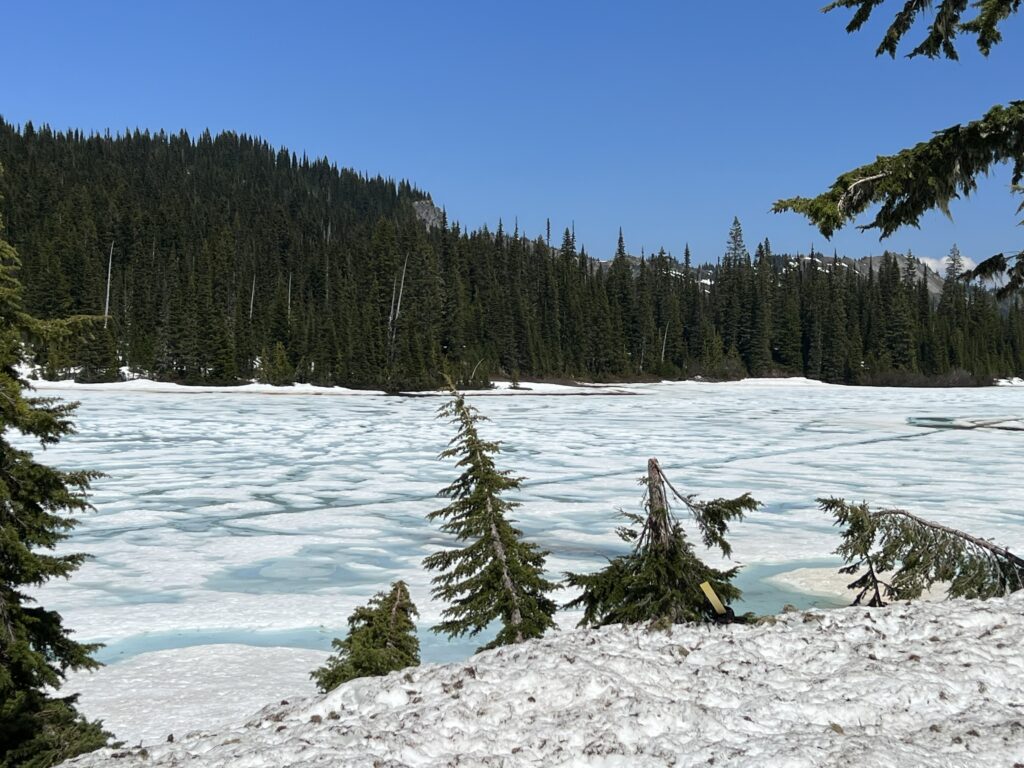
The snow-covered surface of the lake created a striking contrast against the towering peak of Mount Rainier, which loomed majestically in the background. The reflection, distorted by the ice, offered a unique and almost dreamlike view that I hadn’t expected in the middle of June. It was fascinating to witness the lingering remnants of winter as the park transitioned into summer.
Despite the cold, the area around the lake was peaceful and inviting. There were plenty of spots to pause, soak in the scenery, and take photos of the striking landscape. The surrounding forests, still draped in patches of snow, only added to the sense of tranquility. Reflection Lake is a beautiful place no matter the season, offering a different kind of beauty each time you visit. Even with the frozen surface, it was a serene stop that felt like stepping into a winter wonderland, even in the midst of summer.
The Magic of June: Wildflowers, Waterfalls, and Wildlife
June at Mount Rainier is like watching the park come alive. Lower elevations are already lush and green, while higher up, patches of snow still cling to the landscape, making everything feel fresh and new.
The wildflowers were just starting to bloom during my visit, adding splashes of colour to the meadows near Paradise. I’ve never seen anything quite like it—bright purple lupines, fiery red paintbrushes, and delicate white avalanche lilies carpeting the ground. It felt like stepping into a painting.
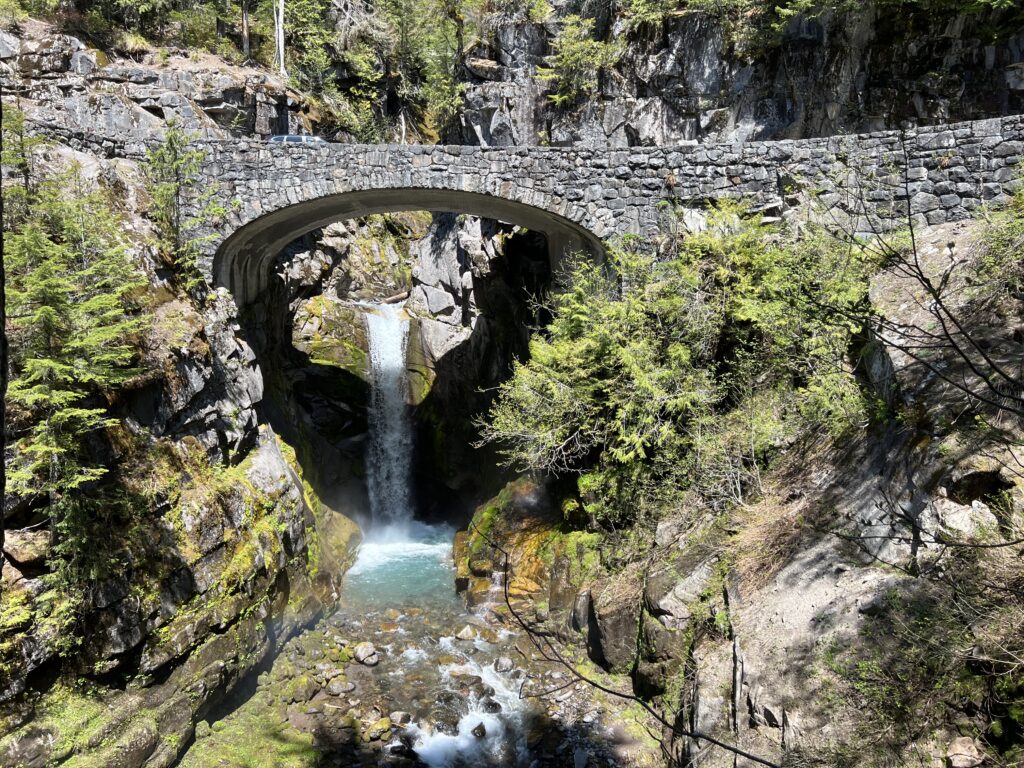
Waterfalls were another highlight of which this national park has many. Christine Falls is one of the most picturesque and accessible waterfalls in the park, located along Paradise Road, just a few miles from the Nisqually Entrance. This stunning two-tiered waterfall drops about 69 feet, with the lower section being the most photographed, cascading 37 feet into a rocky gorge. What makes it even more special is the historic stone bridge that arches over the falls, providing a perfect viewpoint for visitors. Named after Christine Van Trump, the daughter of one of the first climbers to summit Mount Rainier, the waterfall is a serene and memorable stop.
Wildlife spotting is a delightful bonus with a chance to see I marmots, chipmunks, elk and maybe even the black bear!
An English Perspective on the Wilderness
Coming from England, where our landscapes are beautiful but a bit more “tame,” Mount Rainier felt wild and untamed in the best way possible. The sheer scale of everything—the mountain, the forests, the glaciers—was awe-inspiring. It made me feel small in a way that was oddly comforting, like being reminded of my place in the grand scheme of things.
One thing I especially loved was how accessible it all was. You don’t need to be a seasoned adventurer to enjoy the park. There are trails for every ability, from the easy stroll through the Grove of the Patriarchs (a magical forest of ancient trees) to more challenging hikes like the Skyline Trail. And even if hiking isn’t your thing, you can still soak up incredible views from the car or at one of the scenic pullouts.
Practical Tips for Fellow Travellers
• Start early: The Paradise area is popular, and parking fills up quickly. Arriving before 9 AM gave me a head start and a more peaceful experience.
• Dress for the weather: Even in June, it was chilly at higher elevations, so pack layers. I was glad I had a waterproof jacket, too—it’s always a good idea in the Pacific Northwest.
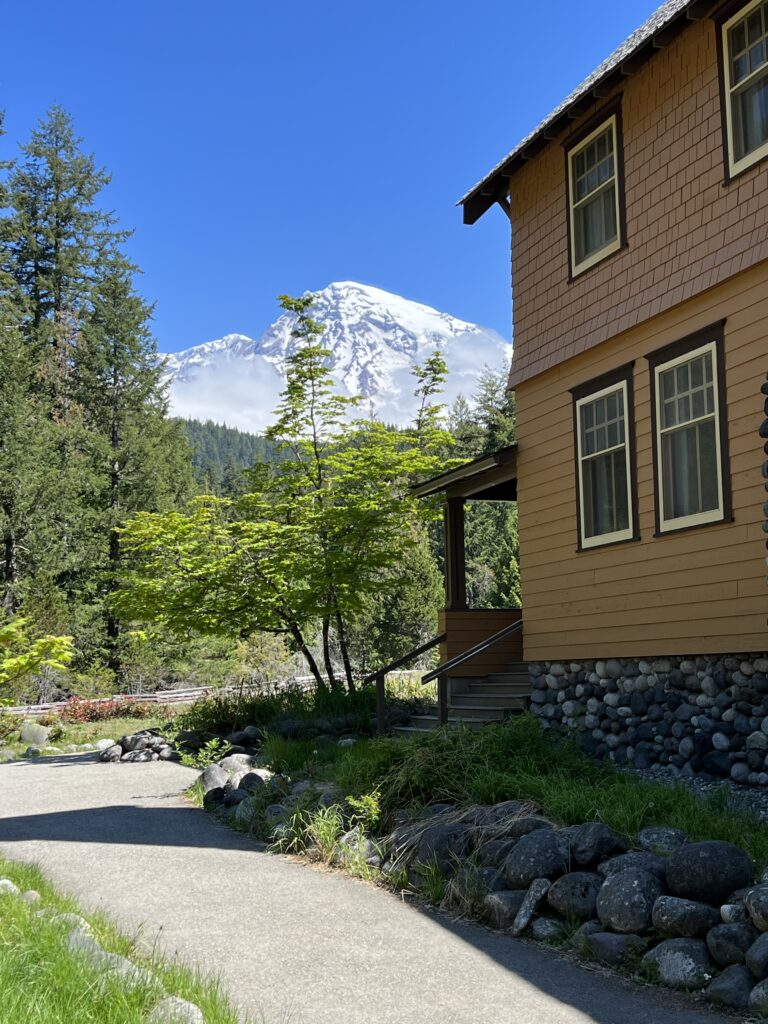
• Bring snacks and water: There aren’t many amenities in the park, so it’s best to come prepared. A packed lunch with a view of Mount Rainier? Unbeatable.
• Be flexible: Some trails were still snow-covered, so I adjusted my plans and asked rangers for up-to-date trail conditions.
A Journey Worth Taking
Leaving Mount Rainier National Park, I felt a little reluctant to go. There’s something about this place that gets under your skin—the raw beauty, the sense of adventure, the way it makes you feel both small and part of something much bigger. As I drove back down the winding roads, catching one last glimpse of the mountain in my rearview mirror, I knew I’d only scratched the surface of what this incredible park has to offer.
For a first-time visitor from England, Mount Rainier National Park was a revelation. It’s the kind of place that leaves you in awe, where every corner holds a new surprise—be it a stunning vista, a playful marmot, or the distant rumble of a glacier. It’s a reminder of the raw power and beauty of nature, and it left me with a deep appreciation for the wild landscapes of the Pacific Northwest.
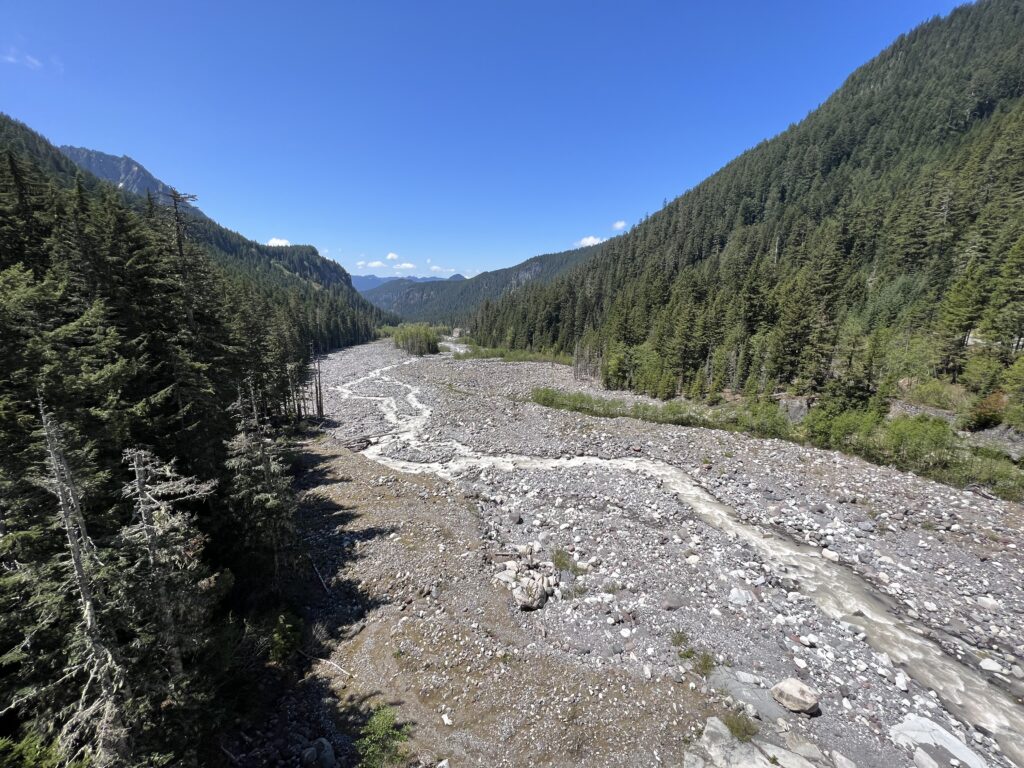
Final Thoughts for Future Visitors
If you’re considering a trip to Mount Rainier and you’re not sure it’s worth the drive—trust me, it absolutely is. Whether you’re an experienced hiker ready to tackle the Wonderland Trail or someone who simply wants to stroll through a meadow and soak in the views, this park has something for everyone.
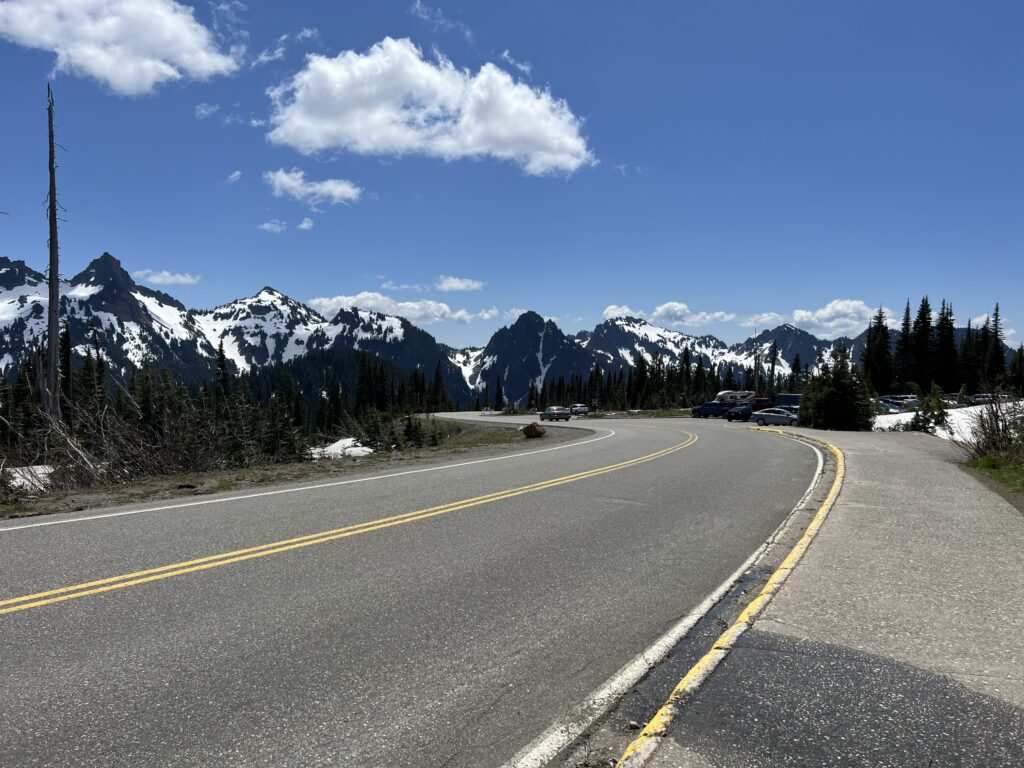
For me, Mount Rainier was a chance to step out of my everyday life and into a world of towering trees, glacial streams, and endless skies. It was a reminder of the beauty that exists when we let nature be wild and free.
So, to my fellow English travellers—or anyone, really—if you ever find yourself in Washington State, don’t miss the chance to visit Mount Rainier National Park. Pack your boots, bring your camera, and prepare to be amazed. As they say in the Pacific Northwest, “The mountain is calling, and you must go.” And after visiting, I can say with certainty: they’re absolutely right.
Like the post? Save it for later…📌
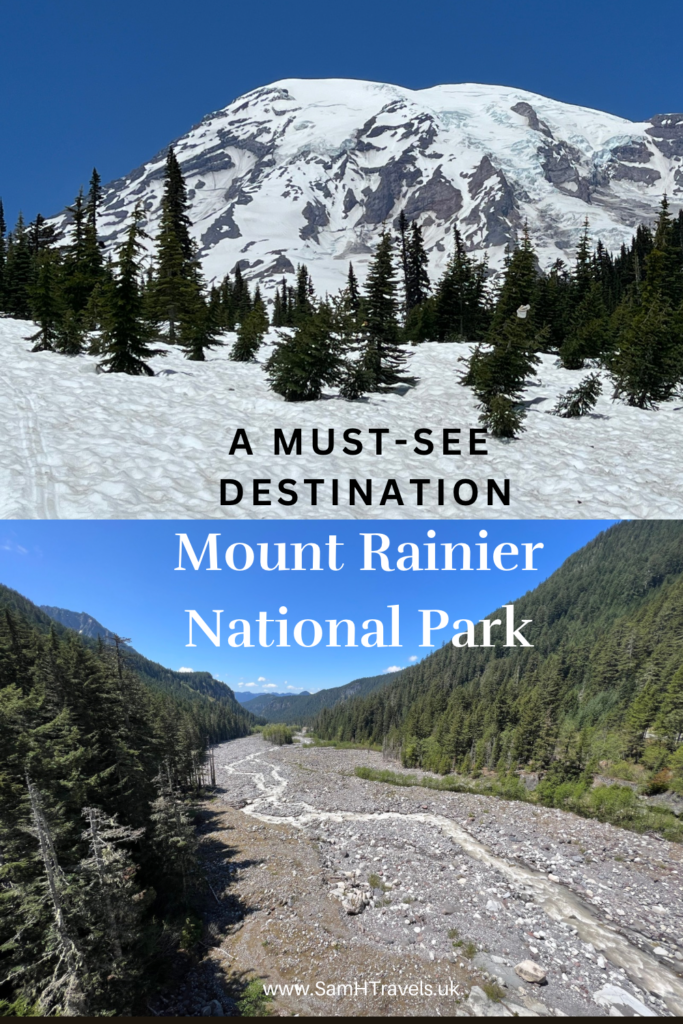
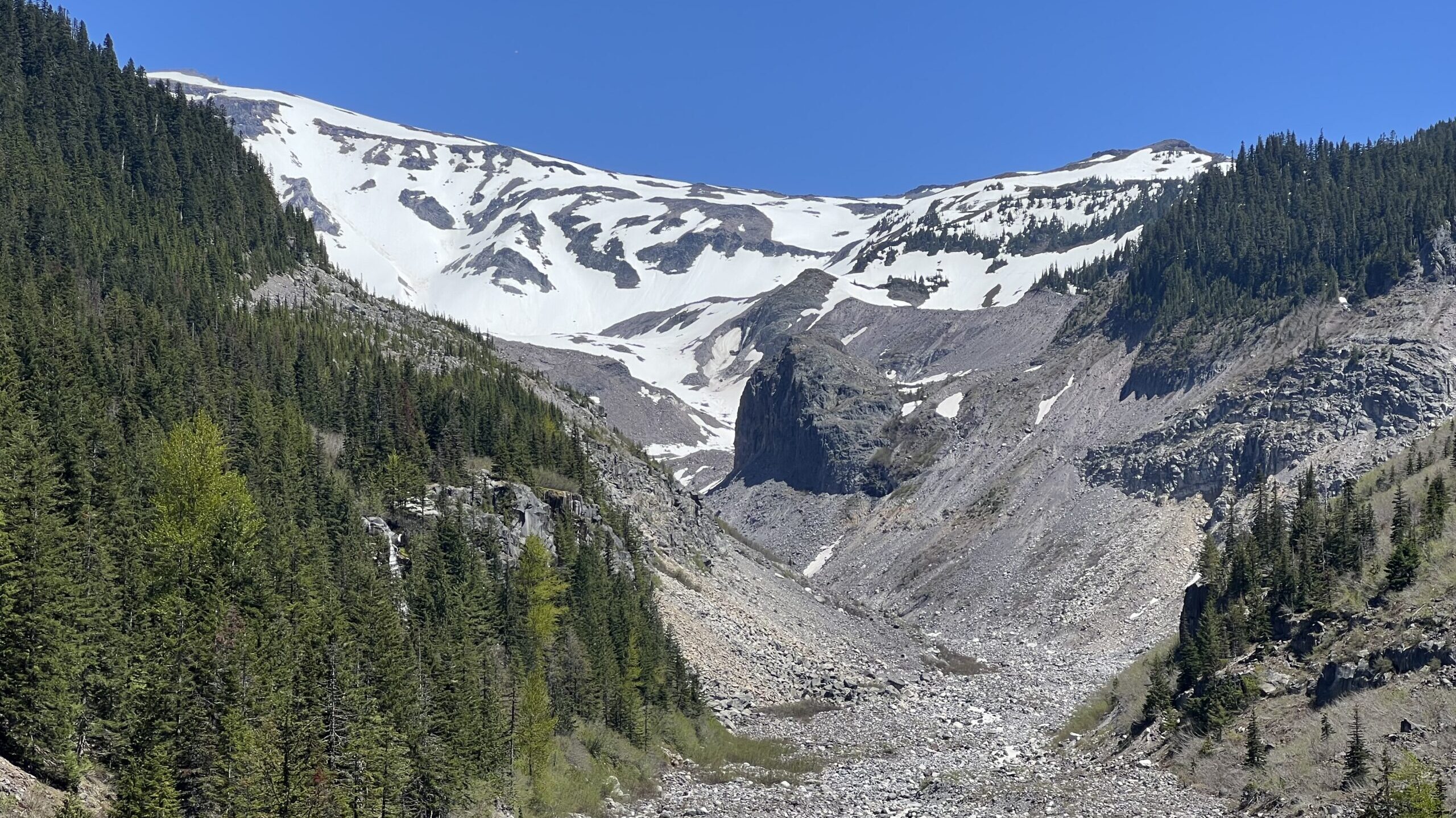

Wow! Mt. Rainier is so beautiful! Thanks for sharing—I’m adding it to my bucket list for sure!
This is on my list of places to see when we go through this year! Thanks for sharing the spots and we will definitely check it out!
Love travel blogs! I have a goal to go to several national parks so this was great for me!
Thanks you for sharing this information about this park. I never heard of it and learned so much.